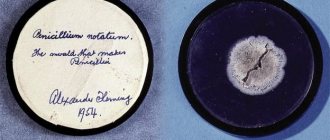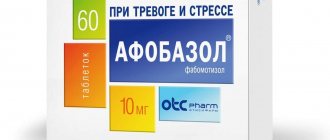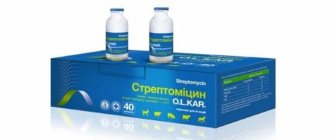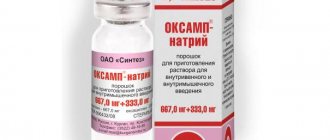"Vancomycin" from the group of glycopeptide antibiotics. It is capable of exerting a bactericidal effect, deforms the synthesis of bacterial cell walls and RNA, and the permeability of the cytoplasmic membrane. Shows activity against gram-positive bacteria: Staphylococcus spp. (including strains that produce penicillinase, as well as methicillin-resistant strains), Enterococcus spp., Listeria spp., Streptococcus spp., Actinomyces spp., Corynebacterium spp., Clostridium spp. (including Clostridium difficile). No cross-resistance was detected with antibiotics of other groups.
Effect from the standpoint of pharmacokinetics
After Vancomycin is taken orally, it is absorbed in very small quantities. A slight increase in drug absorption is observed with inflammation of the intestinal mucosa. In this case, after consuming the drug in an amount of 500 milligrams every six hours, the active substance in the blood plasma reaches a maximum concentration ranging from 2.4 to 3 mg/l.
If the same amount of the drug is administered intravenously, then in patients with normal kidney function the highest level will be approximately 7.3 mg/l. With intravenous administration of Vancomycin in a volume of 1000 milligrams, its concentration in the blood plasma will double. Immediately after the infusion, this indicator will range from 20 to 50 mg/l, and after twelve hours - from 5 to 10. After intravenous administration of 500 milligrams over an hour, the average concentration in plasma at the end of the infusion is approximately 33 mg/l. l, after an hour - 7.3 mg/l, after four hours this figure is 5.7 mg/l.
If Vancomycin from the group of glycopeptide antibiotics is administered repeatedly according to the instructions, its content will be similar to a single use. The distribution volume varies from 0.2 to 1.25 l/kg. If we talk about children, including newborns, then this figure is slightly lower compared to adults: 0.53 – 0.82.
Based on the results of ultrafiltration, it is clear that when the content of Vancomycin in the blood serum is from 10 to 100 mg/l, it binds to plasma proteins by 30-55%. When administered intravenously, the active substance is found in various tissues of the body (kidneys, vascular walls, liver, abscess walls, heart, atrial appendage tissue, lungs), in fluids (pleural, ascitic, pericardial, synovial, peritoneal), in urine (in inhibiting increasing the sensitivity of microorganisms concentration).
It has been noted that “Vancomycin” from the group of glycopeptide antibiotics slowly penetrates the fluid of the spinal cord, but with inflammation of its membranes, a directly proportional increase in the rate of passage of the drug through the blood-brain barrier has been recorded.
The antibiotic penetrates the placental barrier and, accordingly, enters breast milk.
The drug "Vancomycin" (photo) from the group of glycopeptide antibiotics is almost not metabolized. If kidney function is normal, then on average its half-life from plasma ranges from 4 to 6 hours. Approximately 75 percent of the drug dose is excreted by the kidneys through glomerular filtration in the first 24 hours. But excretion with bile is observed in small quantities. The same applies to hemodialysis or peritoneal dialysis.
The average plasma clearance is approximately 0.058 l/kg/h, renal clearance is 0.048. After permanent renal clearance, Vancomycin is excreted by 70–80 percent. If there are disturbances in the functioning of the kidneys, this process slows down. During anuria, the average half-life is 7.5 days. Due to glomerular filtration, which is naturally slow in elderly patients, the overall systemic and renal clearance of Vancomycin may be reduced.
Vancomycin
Active substance:
Vancomycin*
Pharmgroup:
Glycopeptides
Average price in pharmacies
| Name | Manufacturer | average price |
| Vancomycin Elfa 1.0 n1 bottle por d/r-ra d/inf | ELF | 244.00 |
Analogs for the active substance:Vancoled Vancomabol Vancomycin sterile Vancomycin-Teva Vancomycin hydrochloride Vancorus Vankotsin Vanmiksan Vero-Vancomycin Editsin |
Indications
Indications for the use of Vancomycin from the group of glycopeptide antibiotics include infectious and inflammatory diseases characterized by severe progression and caused by pathogens sensitive to the active substance of the drug (in case of intolerance or ineffectiveness of treatment with other antibiotics, which also include cephalosporins or penicillins):
- endocarditis (as monotherapy or part of a combination antibiotic therapy);
- sepsis;
- lung abscess;
- skin infections;
- pneumonia;
- soft tissue infections;
- pseudomembranous colitis caused by Clostridium difficile;
- meningitis.
Buy Vancomycin lyophilisate for infusion 1g in pharmacies
Vancomycin Buy Vancomycin in pharmacies DOSAGE FORMS powder for the preparation of infusion solution 1g lyophilized powder for the preparation of intravenous solution 1000 mg
MANUFACTURERS Kraspharma (Russia)
GROUP Antibiotics of different groups
COMPOSITION Active ingredient: Vancomycin.
INTERNATIONAL NON-PROPENTED NAME Vancomycin
SYNONYMS Vancomycin J, Vancomycin Qualimed, Vancomycin-Teva, Vancorus, Vancocin, Vanmiksan, Vero-Vancomycin, Editsin
PHARMACOLOGICAL ACTION Antibacterial (bactericidal). It disrupts the formation of the shell of microorganisms, the permeability of their cytoplasmic membrane and RNA synthesis. When administered orally, it is not absorbed. Practically does not bind to blood plasma proteins. With repeated administration, cumulation is possible. Quickly penetrates into the cavity of the pleura and pericardium, synovial and ascitic fluid. Found in bile and cerebrospinal fluid (with meningitis). When administered parenterally, it is almost completely eliminated through the kidneys. When administered orally, it is almost entirely excreted in the feces. In patients with impaired renal function and the elderly, excretion is slowed down. Affects gram-positive flora, is active against staphylococci (including penicillinase-forming and methicillin-resistant strains), streptococci, pneumococci, enterococci (including E.faecium), corynebacteria, listeria, actinomycetes and clostridia. The optimum action is at pH 8; when pH decreases to 6, the effect decreases sharply. Actively affects only microorganisms that are in the stage of reproduction.
INDICATIONS FOR USE Severe infectious and inflammatory diseases caused by pathogens sensitive to vancomycin (with ineffectiveness and intolerance to penicillins, cephalosporins and other antibiotics): sepsis, endocarditis, pneumonia, lung abscess, osteomyelitis, infections of the skin and skin structures, pseudomembranous colitis caused by Clostridium difficile, enterocolitis, meningitis.
CONTRAINDICATIONS Hypersensitivity, acoustic neuritis, pregnancy (first trimester). Restrictions on use: Severe kidney damage, hearing impairment, pregnancy (II and III trimester), breastfeeding (breastfeeding should be suspended).
SIDE EFFECTS : Nausea, vomiting, bitter taste in the mouth, chills, itchy skin, urticaria, Stevens-Johnson syndrome. After intravenous administration - thrombophlebitis, vasculitis, fever, neutropenia, eosinophilia, thrombocytopenia, and sometimes anaphylactoid reactions. With rapid intravenous administration, a burning sensation, redness of the upper body (red neck syndrome), pain and muscle spasms in the back and chest, arterial hypotension, dizziness, and tinnitus are possible. In rare cases, oto- and nephrotoxic effects (hearing loss up to deafness, renal failure, azotemia, interstitial nephritis).
INTERACTION When combined with aminoglycosides, amphotericin B, bacitracin, loop diuretics, cisplatin, cyclosporine, polymyxins, the risk of hearing loss and kidney damage increases. Cholestyramine reduces effectiveness. Concomitant use with general anesthetics can lead to the development of erythema, histamine-like flushes and anaphylactic shock.
METHOD OF APPLICATION AND DOSAGE IV drip. Adults - 0.5 g every 6 hours or 1 g every 12 hours. To avoid collaptoid reactions, the duration of infusion is at least 60 minutes. Children are prescribed a daily dose of 40 mg/kg, each dose should be administered over at least 60 minutes. In patients with impaired renal excretory function, the dose is reduced taking into account creatinine Cl values. For pseudomembranous colitis, it is prescribed orally in the form of a solution: for adults - in a daily dose of 0.5-2 g (in 3-4 doses), for children - 40 mg/kg (in 3-4 doses).
OVERDOSE Characterized by increased severity of side effects. Treatment: symptomatic in combination with hemoperfusion and hemofiltration.
SPECIAL INSTRUCTIONS No data available.
STORAGE CONDITIONS List B. In a dry place, protected from light, at room temperature.
Dosage
The drug is administered intravenously through a dropper. For adults, the dosage is 500 milligrams applied every six hours, or 1 gram every 12 hours. To avoid collaptoid reactions, the infusion should last at least 60 minutes. The dose for children is 40 milligrams per kilogram per day, each administered over an hour. In patients with impaired renal excretory function, it, accordingly, decreases based on CC indicators.
Also, depending on the etiology of the disease, Vancomycin can be taken orally. The daily dose for adults varies from 500 milligrams to 2 grams in three or four doses, the dose for children is 40 milligrams per kilogram with the same number of doses. When administered intravenously to adult patients, the maximum allowable dose is 3–4 grams.
Side effect
Side effects from the use of Vancomycin from the group of glycopeptide antibiotics are:
- heart failure;
- decrease in blood pressure;
- tides;
- shock (these symptoms are mainly caused by rapid infusion of the drug);
- eosinophilia;
- neutropenia;
- nausea;
- agranulocytosis;
- thrombocytopenia;
- renal function test deformities;
- interstitial nephritis;
- renal dysfunction;
- tinnitus;
- vertigo;
- exfoliative dermatitis;
- itchy dermatosis;
- ototoxic effects;
- Stevens-Johnson syndrome;
- blistering benign dermatosis;
- vasculitis;
- hives;
- rash;
- epidermal necrolysis of a toxic nature;
- anaphylactoid type reactions;
- drug fever;
- chills;
- tissue necrosis in the places where the injection was given and pain in these areas;
- thrombophlebitis;
- erythema;
- the appearance of red neck syndrome, which is caused by the release of histamine;
- skin rash;
- redness of the neck, face, arms and upper body;
- increased heart rate;
- vomit;
- nausea;
- temperature increase;
- chills;
- fainting.
Contraindications
Among the contraindications to the use of Vancomycin are:
- obvious impairment of renal function;
- acoustic neuritis;
- first trimester of pregnancy;
- lactation period;
- increased sensitivity of the patient to vancomycin, the active substance of the drug.
What is the use of Vancomycin from the group of glycopeptide antibiotics by pregnant women and nursing mothers?
Due to the fact that oto- and nephrotoxicity can develop, the use of the drug in the first trimester of pregnancy is prohibited. In the second and third trimester, Vancomycin can be used only if there are vital indications. If the need arises, you should stop breastfeeding the baby.
Vancomycin® analogues in tablets
There are no analogues of vancomcin® in tablets.
Vancorus® (from 140 to 370 rubles) is an antibiotic - a glycopeptide that is produced by Amycolatopsis orientalis. Acts on bacteria that are in the reproduction stage. Country of origin: Russia.
Vancoled® (from 240 to 340 rubles) is well distributed in tissues and liquids. It penetrates the blood-brain barrier poorly. Country of origin: USA.
Editsin® (from 240 to 730 rubles) is an antibiotic that has a bactericidal effect. Strains that produce penicillinase are sensitive to it. Country of origin: Serbia.
Vancomycin® is also available in pharmacies under the following trade names:
- Vancocin® (from 240 to 340 rubles)
- Vanmiksan® (from 240 to 340 rubles)
- Vero-Vancomycin® (from 150 to 530 rubles)
- Vancomycin® (Kraspharma®) (from 230 to 250 rubles)
- Vancomycin-Qualimed® (from 240 to 335 rubles)
- Vancomycin-Teva® (from 240 to 620 rubles)
Vacomycin® and alcohol
Vancomycin® cannot be combined with alcoholic beverages. It is recommended to avoid drinking alcohol during antibiotic treatment. Alcohol intake can lead to toxic damage to the liver and central nervous system.
Pregnancy and vancomycin®
Can be prescribed to pregnant patients only for health reasons. If a safe alternative is available, it is recommended to use a different antimicrobial agent.
If Vancomycin® is prescribed to a breastfeeding woman, breastfeeding should be temporarily stopped.
Drug interactions
The use of Vancomycin along with certain drugs can cause a number of negative reactions:
- when combined with cisplatin, polymyxins, amphotercine and diuretics, the kidneys and hearing organs are at risk;
- when used simultaneously with phenobarbital, a group of corticosteroids and heparin;
- when taken with anesthetics, skin erythema with dilation of capillaries in the facial area was detected in children; in adults, heart rhythm defects and blockade may occur;
- cholestyramine reduces effectiveness.
- It is necessary to avoid combining the drug with antibiotics of the beta-lactam type.
When treating premature babies, it is necessary to monitor the concentration of the drug in the blood serum. During the treatment period, the doctor prescribes kidney diagnostics and hearing examinations.








